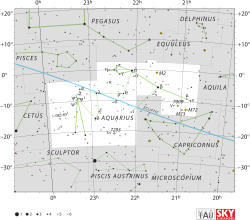Iota Aquarii
| Observation data Epoch J2000 Equinox J2000 | |
|---|---|
| Constellation | Aquarius |
| Right ascension | 22h 06m 26.22742s[1] |
| Declination | –13° 52′ 10.8615″[1] |
| Apparent magnitude (V) | 4.279[2] |
| Characteristics | |
| Spectral type | B8 V[3] |
| U−B color index | –0.288[2] |
| B−V color index | –0.062[2] |
| Astrometry | |
| Radial velocity (Rv) | –10.0[4] km/s |
| Proper motion (μ) | RA: +36.89[1] mas/yr Dec.: –58.99[1] mas/yr |
| Parallax (π) | 18.62 ± 0.22 mas[1] |
| Distance | 175 ± 2 ly (53.7 ± 0.6 pc) |
| Absolute magnitude (MV) | +0.64[5] |
| Details | |
| Radius | 2.7[6] R☉ |
| Luminosity | 74[5] L☉ |
| Surface gravity (log g) | 4.09 ± 0.08[7] cgs |
| Temperature | 11,284 ± 284[6] K |
| Metallicity [Fe/H] | –0.08 ± 0.12[7] dex |
| Rotational velocity (v sin i) | 135[8] km/s |
| Age | 30–60[9] Myr |
| Other designations | |
| Database references | |
| SIMBAD | data |
Iota Aquarii, Latinized from ι Aquarii, is the Bayer designation for a star in the equatorial constellation of Aquarius. It is visible to the naked eye with an apparent magnitude of +4.279.[2] Based upon parallax measurements made during the Hipparcos mission, the distance to this star is around 175 light-years (54 parsecs).[2]
The spectrum of this star fits a stellar classification of B8 V,[3] showing that this is a B-type main sequence star. It has 2.7[6] times the radius of the Sun and is spinning rapidly with a projected rotational velocity of 135 km/s.[8] A 2010 infrared search for companions around this star was unsuccessful.[9]
References
- ^ a b c d e van Leeuwen, F. (November 2007), "Validation of the new Hipparcos reduction", Astronomy and Astrophysics, 474 (2): 653–664, arXiv:0708.1752, Bibcode:2007A&A...474..653V, doi:10.1051/0004-6361:20078357.
- ^ a b c d e Kozok, J. R. (September 1985), "Photometric observations of emission B-stars in the southern Milky Way", Astronomy and Astrophysics Supplement Series, 61: 387–405, Bibcode:1985A&AS...61..387K.
- ^ a b Houk, Nancy (1978), Michigan catalogue of two-dimensional spectral types for the HD stars, vol. 4, Ann Arbor: Dept. of Astronomy, University of Michigan, Bibcode:1988mcts.book.....H.
- ^ Wielen, R.; et al. (1999), Sixth Catalogue of Fundamental Stars (FK6). Part I. Basic fundamental stars with direct solutions, Astronomisches Rechen-Institut Heidelberg, Bibcode:1999VeARI..35....1W.
- ^ a b Anderson, E.; Francis, Ch. (2012), "XHIP: An extended hipparcos compilation", Astronomy Letters, 38 (5): 331, arXiv:1108.4971, Bibcode:2012AstL...38..331A, doi:10.1134/S1063773712050015.
- ^ a b c Underhill, A. B.; et al. (November 1979), "Effective temperatures, angular diameters, distances and linear radii for 160 O and B stars", Monthly Notices of the Royal Astronomical Society, 189: 601–605, Bibcode:1979MNRAS.189..601U, doi:10.1093/mnras/189.3.601.
- ^ a b Wu, Yue; et al. (January 2011), "Coudé-feed stellar spectral library - atmospheric parameters", Astronomy and Astrophysics, 525: A71, arXiv:1009.1491, Bibcode:2011A&A...525A..71W, doi:10.1051/0004-6361/201015014.
- ^ a b Abt, Helmut A.; Levato, Hugo; Grosso, Monica (July 2002), "Rotational Velocities of B Stars", The Astrophysical Journal, 573 (1): 359–365, Bibcode:2002ApJ...573..359A, doi:10.1086/340590.
- ^ a b Ehrenreich, D.; et al. (November 2010), "Deep infrared imaging of close companions to austral A- and F-type stars", Astronomy and Astrophysics, 523: A73, arXiv:1007.0002, Bibcode:2010A&A...523A..73E, doi:10.1051/0004-6361/201014763.
- ^ "* iot Aqr". SIMBAD. Centre de données astronomiques de Strasbourg. Retrieved 2012-06-30.
{{cite web}}: CS1 maint: postscript (link)

